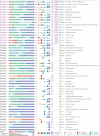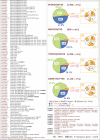Comparative genomics of transcriptional control in the human malaria parasite Plasmodium falciparum
- PMID: 15256513
- PMCID: PMC509263
- DOI: 10.1101/gr.2218604
Comparative genomics of transcriptional control in the human malaria parasite Plasmodium falciparum
Abstract
The life cycle of the parasite Plasmodium falciparum, responsible for the most deadly form of human malaria, requires specialized protein expression for survival in the mammalian host and insect vector. To identify components of processes controlling gene expression during its life cycle, the malarial genome--along with seven crown eukaryote group genomes--was queried with a reference set of transcription-associated proteins (TAPs). Following clustering on the basis of sequence similarity of the TAPs with their homologs, and together with hidden Markov model profile searches, 156 P. falciparum TAPs were identified. This represents about a third of the number of TAPs usually found in the genome of a free-living eukaryote. Furthermore, the P. falciparum genome appears to contain a low number of sequences, which are highly conserved and abundant within the kingdoms of free-living eukaryotes, that contribute to gene-specific transcriptional regulation. However, in comparison with these other eukaryotic genomes, the CCCH-type zinc finger (common in proteins modulating mRNA decay and translation rates) was found to be the most abundant in the P. falciparum genome. This observation, together with the paucity of malarial transcriptional regulators identified, suggests Plasmodium protein levels are primarily determined by posttranscriptional mechanisms.
Copyright 2004 Cold Spring Harbor Laboratory Press ISSN
Figures


Similar articles
-
Combinatorial gene regulation in Plasmodium falciparum.Trends Genet. 2006 Feb;22(2):73-8. doi: 10.1016/j.tig.2005.12.002. Epub 2005 Dec 27. Trends Genet. 2006. PMID: 16380193 Review.
-
The mRNA-bound proteome of the human malaria parasite Plasmodium falciparum.Genome Biol. 2016 Jul 5;17(1):147. doi: 10.1186/s13059-016-1014-0. Genome Biol. 2016. PMID: 27381095 Free PMC article.
-
Genome-Wide Collation of the Plasmodium falciparum WDR Protein Superfamily Reveals Malarial Parasite-Specific Features.PLoS One. 2015 Jun 4;10(6):e0128507. doi: 10.1371/journal.pone.0128507. eCollection 2015. PLoS One. 2015. PMID: 26043001 Free PMC article.
-
The Hsp40 proteins of Plasmodium falciparum and other apicomplexa: regulating chaperone power in the parasite and the host.Int J Biochem Cell Biol. 2007;39(10):1781-803. doi: 10.1016/j.biocel.2007.02.011. Epub 2007 Feb 22. Int J Biochem Cell Biol. 2007. PMID: 17428722 Review.
-
Genome wide in silico analysis of Plasmodium falciparum phosphatome.BMC Genomics. 2014 Nov 25;15:1024. doi: 10.1186/1471-2164-15-1024. BMC Genomics. 2014. PMID: 25425018 Free PMC article.
Cited by
-
The characterization of extracellular vesicles-derived microRNAs in Thai malaria patients.Malar J. 2020 Aug 10;19(1):285. doi: 10.1186/s12936-020-03360-z. Malar J. 2020. PMID: 32778117 Free PMC article.
-
PfSRPK1, a novel splicing-related kinase from Plasmodium falciparum.J Biol Chem. 2010 Dec 3;285(49):38315-23. doi: 10.1074/jbc.M110.119255. Epub 2010 Sep 24. J Biol Chem. 2010. PMID: 20870716 Free PMC article.
-
Autophagy Underlies the Proteostasis Mechanisms of Artemisinin Resistance in P. falciparum Malaria.mBio. 2022 Jun 28;13(3):e0063022. doi: 10.1128/mbio.00630-22. Epub 2022 Apr 14. mBio. 2022. PMID: 35420484 Free PMC article.
-
Using context to improve protein domain identification.BMC Bioinformatics. 2011 Mar 31;12:90. doi: 10.1186/1471-2105-12-90. BMC Bioinformatics. 2011. PMID: 21453511 Free PMC article.
-
Dynamic RNA profiling in Plasmodium falciparum synchronized blood stages exposed to lethal doses of artesunate.BMC Genomics. 2008 Aug 18;9:388. doi: 10.1186/1471-2164-9-388. BMC Genomics. 2008. PMID: 18706115 Free PMC article.
References
-
- Adams, M.D., Celniker, S.E., Holt, R.A., Evans, C.A., Gocayne, J.D., Amanatides, P.G., Scherer, S.E., Li, P.W., Hoskins, R.A., Galle, R.F., et al. 2000. The genome sequence of Drosophila melanogaster. Science 287: 2185–2195. - PubMed
-
- The Arabidopsis Genome Initiative. 2000. Analysis of the genome sequence of the flowering plant Arabidopsis thaliana. Nature 408: 796–815. - PubMed
Publication types
MeSH terms
LinkOut - more resources
Full Text Sources
Other Literature Sources
